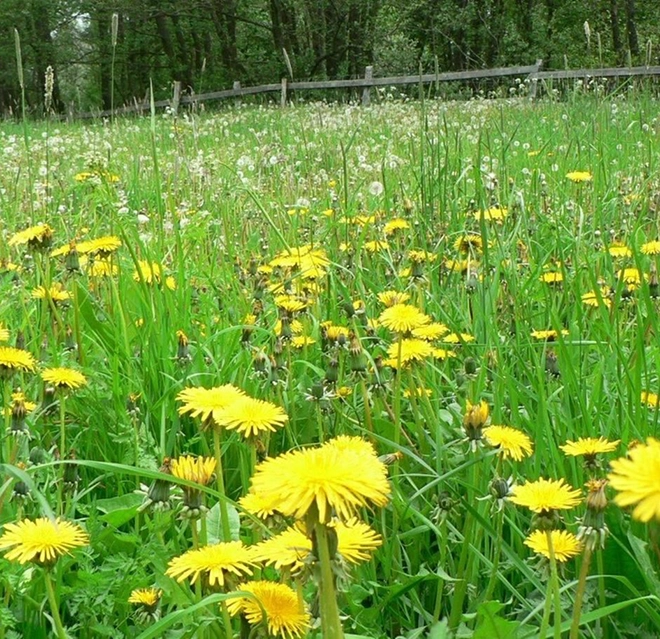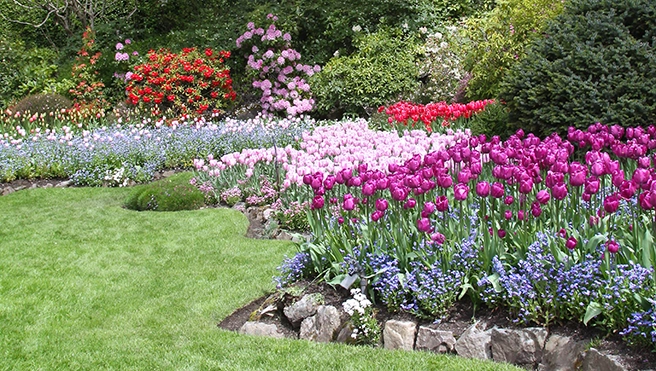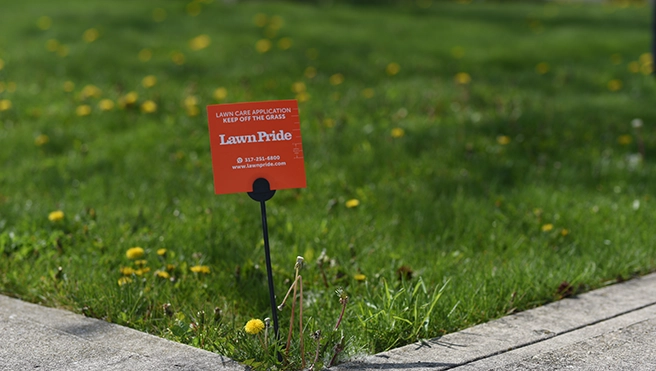As spring returns, the soil warms up, essential microbes stir, and dormant grass is ready to wake up and grow. Learn the essentials of spring lawn care and landscape maintenance from the pros at Lawn Pride®, and you (and your lawn) will be ready for the new season.
Spring Lawn Care Steps: Essential Tips for Lawn Maintenance
Preparing Your Lawn for Spring
Spring is the ideal time to refresh your lawn and ensure it has the best conditions to grow lush and healthy. Start with the following tasks for lawn preparation.
Initial Cleanup: Rake and Dethatching Basics
The first spring lawn care step is cleanup. Once the spring thaw makes it safe to walk on your lawn without damaging it, it’s time to get to work. Remove twigs and fallen leaves before your first spring mowing, then thoroughly rake the lawn to loosen up and remove thatch.
Soil Aeration Basics: When and How
The next step in spring lawn care is soil aeration. It’s best to aerate the soil; of cool-season grasses in early spring, but you can wait until late spring or summer for warm-season grasses. You can find manual aerator tools that clip onto your shoes, upright tools you step on, or push-style aerators at your local home store. Soil aeration is an essential part of spring lawn care that breaks up compacted soil, removes thatch, and revitalizes roots by improving their oxygen, water, and mineral uptake.

Fertilizing for Spring

Seeding and Lawn Regeneration
At Lawn Pride, we don’t consider full lawn reseeding a part of spring lawn care. Instead, we recommend waiting until fall to seed your lawn. This is for two reasons. First, when seeding in the spring, your lawn can’t have any weed control or pre-emergent applied until the new grass has germinated and grown tall enough to be mowed twice. Young grass cannot handle weed control and will die if it is applied too soon.
The second reason is that since weed control cannot be applied, your new grass will have to fight for room to grow with faster-growing weeds.
Let’s face it: seeding your lawn isn’t cheap. You want the best results possible when you spend your hard-earned money on seeding. The only exception to waiting on seeding is when your lawn has less than 50% grass. In that case, any green is better than dirt!
Of course, reseeding targeted locations is an ideal way to repair brown or bare spots in the lawn.
Seeding Techniques
Aerate (break up the soil) before seeding. This allows for better seed-to-soil contact, increasing the likelihood of good germination.
New seeds need to stay moist for proper germination. If you don’t have sufficient rainfall, water the seeds lightly each day.
Tackle Bare Spots: Seed Types and Timing
Reseeding helps you fill in bare spots. Stick with the grass seed blend of your existing lawn for a uniform look. Cool-season grasses can be reseeded to repair bare patches all spring, but late spring to early summer is better for warm-season grasses.
Spring Pest & Weed Control
When spring is in the air, grass, soil microbes, pests, and weeds wake up and begin to feed and grow. Take some proactive steps and get ahead of them!
Early Identification and Control of Spring Weeds
Spring is the perfect time to use a pre-emergent herbicide in northern climates to stop crabgrass from invading your lawn. In southern gardens, use a weed control treatment that targets broadleaf weeds.
Spring Grub Control and Treatment
As you conduct these spring lawn care steps, you’ll likely encounter grubs in other parts of the garden, like your flower beds. The grubs you find at this time of the year are not the ones that damage your lawn. However, the grubs you have now will soon transform into the beetles that will deliver the next generation of grubs that will cause turf damage. Spring is also when grub damage from late summer and fall becomes the most visible as the lawn greens up.
Applying nematodes (microscopic worms) in the spring can help prevent grub infestations from getting out of control. These natural predators enter grubs' bodies and release bacteria that are lethal to them. Or, consider Lawn Pride’s unique grub control program, which comes with a one-of-a-kind guarantee. If you use the program and continue to have grub damage, we will come back and treat your lawn again and restore it to its prior condition at no additional charge!

Fungus Among Us: Prevention and Cure
Spring weather can bring unwanted turf fungal infections such as red thread and dollar spot. These diseases can develop at any time of the year but are most common in the spring and fall when temperatures are cooler and the soil is frequently too wet. The best prevention for lawn fungus is to:
- Avoid overwatering
- Water early in the morning so the grass dries in the sun
- Leave grass at least three inches long (too-short grass is hospitable to fungus and disease)
Some types of lawn diseases can be treated with a simple nitrogen-rich fertilizer. In severe cases, a fungicide treatment may be needed.

Mowing Strategies for Spring Health and Growth
The tips and tricks for optimal mowing are essential pieces of the lawn maintenance puzzle. Getting the mowing right is critical to your lawn’s health.
Mowing Recommendations: Frequency and Height
Depending on the type of grass, set the mower to about 3 to 4 inches. There are many benefits to mowing tall. It promotes deeper root growth, improving drought tolerance. Tall turf also provides better shade for the root system, helping to conserve water and block out the growth of unwanted weeds. Additionally, longer grass produces more food for the roots through photosynthesis, reducing the need for fertilizer.
Alternate your mowing direction with each new mow. Always mowing the same pattern encourages your grass to grow in the direction you mow. Varying the direction promotes straighter blade growth, which makes your grass stronger and more resilient at the same time.
When mowing, follow the one-third rule and remove only the top third of your grass blades. If you cut much shorter than that, you risk damaging, weakening, or even killing your grass. In spring, lawn care may require mowing weekly or even more often to keep up with your grass growth.
When to Mow
Knowing when to mow the lawn in spring will increase your chances of successful seasonal maintenance. For general lawn maintenance, it is best to mow after the morning dew has evaporated but before the hottest time of day. Mowing wet grass can cause the cut grass to form clumps. If clumps are left on the lawn, they will block the sunlight, causing the grass below the clumps to turn yellow. Mowing slick, wet grass is also hard on your lawn mower, causing a ragged and torn grass leaf rather than an even cut. Wet, stuck-on grass also causes corrosion damage to the lawn mower.
The Importance of Sharp Mower Blades
Whether your lawn mower is new or old, your mower blade should be sharpened often. A sharp blade produces a clean cut, is less damaging to the lawn, and does not overburden the engine, thereby lengthening the functional life of your mower. Also, you should replace the blade when it develops any nicks, bends, or other damage.
Lawn Clipping Management: Mulch or Remove?
Grass clippings are one of the easiest and most effective ways to feed your lawn. As grass clippings break down, they return nutrients to the soil. Only do this when the grass is dry because wet grass clumps together and can kill the growing leaves beneath it.
Troubleshooting Common Spring Lawn Problems
Spring lawn care and landscape maintenance are complex. When you run into questions, your local Lawn Pride experts have the answers you need for a lush and healthy lawn.
Request a Free Quote for Lawn Care Services Today
If you don’t have the time for the spring lawn care and landscape maintenance you need, call on the pros at Lawn Pride. Let our professional lawn care services turn your grass into the lush green lawn that will be the envy of the neighborhood.
We take pride in our work and your lawn. You can count on being pleased with our service because the Neighborly Done Right Promise® backs everything we do. We get the job done right the first time.
Request a free quote or contact us today. Let’s make yours a lawn you’ll be proud of.
FAQ: Answers to Your Spring Lawn Care Questions
Our Special Offers
We understand your goal to keep your lawn looking its best. We take pride in your lawn because we know you do, too. Check out our special offers to see how you can save on your next lawn care application.
